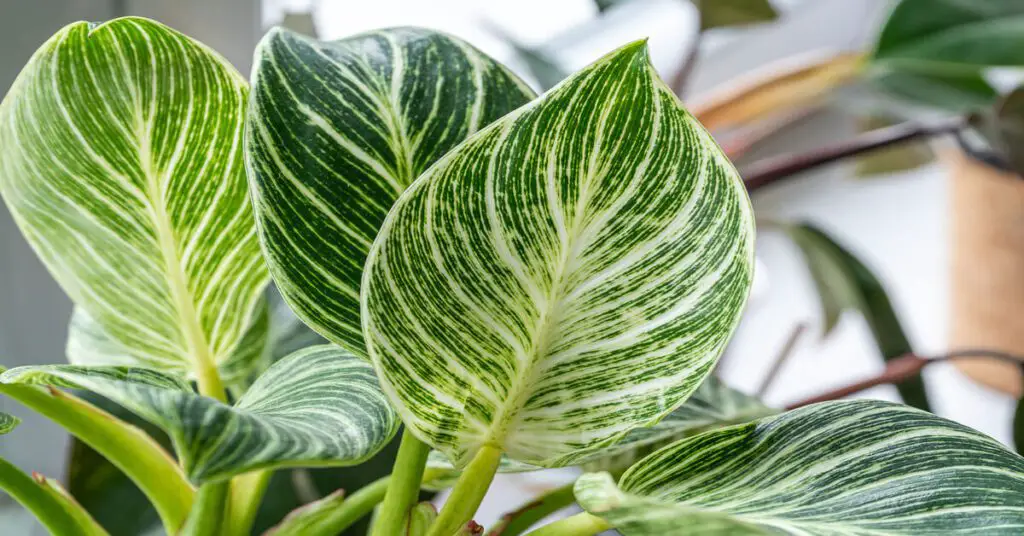Philodendrons were first discovered in Brazilian rainforests centuries ago. However, the Philodendron Birkin is a newer araceae hybrid on the plant market.
Some believe Birkins are a result of a rare gene mutation of the Philodendron Rojo Congo. Others theorize that the plant is a hybrid of Rojo Congo and Green Leaf Philodendron.
Regardless of how the Birkin came to be, one thing is for sure: it’s a unique-looking plant. It’s characterized by glossy, dark-green, rounded leaves with pointy tips. However, it’s mainly noted for its fine, eye-catching variegation.
Philodendron Birkin Plant Care
Birkin Philodendrons aren’t exactly easy to come across. Although, they are easier to find than when they first came out.
Rest assured that if you do get your hands on one, they’ll be simple to care for. In addition, the Philodendron Birkin is a fast-growing houseplant.
Learn how to care for your Philodendron Birkin below.
Soil
Philodendron Birkins best thrive when planted in soil that retains moisture well (but without suffocating the plant). Consider a soil that is nutrient-dense and well-aerated.
Watering
Keep the soil of your Birkin damp, but refrain from watering if the top layer of soil is still wet. Watering once or a twice a week is usually best for Birkin plants.
Lighting
Philodendron Birkins don’t like direct sunlight nor do they like low light. Provide them with bright yet indirect lighting. Preferably, place them near a window that gets morning sun.
Humidity & Temperature
Due to its tropical origins, Philodendrons like the Birkin enjoy humidity. That said, they would thrive in bathrooms.
If the location where you plan to place your Birkin doesn’t get very humid, you can mimic a humid environment by spritzing its foliage with water.
Fertilizing
Give your Birkin the energy it needs to continue growing quickly by fertilizing it once a month in the spring and summer.
Propagation
Birkin propagation is done via cuttings. Take a cutting during the warmer months, and place it in rich soil. Roots should form within three weeks or so.
Diseases & Pests
Overwatered Philodendron Birkins are prone to bacterial leaf spot and bacterial blight. The plant rarely gets pests, but when it does, it’s usually scale, thrips, mealybugs, or spider mites.
Toxicity
Birkin Philodendrons are toxic to pets and children when ingested due to its calcium oxalate crystals.
Philodendron Birkin Variegation Reverting
Birkins are prone to something called variegation reverting. This is when their leaves lose their white or cream variegation. The foliage turns solid green as it reverts back to its Philodendron Rojo Congo roots.
Variegation reverting doesn’t always happen. However, it is a natural and relatively common process for the Birkin plant. It occurs due to unsuitable environmental factors.
Not all hope is lost. You can stop variegation reverting in its tracks.
Providing more sunlight for your Birkin is usually the solution to variegation reverting.
Philodendron Birkin Pink
Normally, Philodendron Birkins showcase white or cream variegation. There is a Birkin variety, however, that features pink coloration on its leaves.
This variety of Philodendron is extra hard to come across. The more it matures, the more its variegation turns a blush pink.
Philodendron Birkin vs Calathea
Calatheas and Philodendron Birkins may look alike. However, they’re two totally different plants.
One of the most obvious differences is that Birkins tend to have thicker stems than Calathea. In addition, the foliage stripes of Birkins tend to be a lot thinner. Many Calathea varieties also have less pointy leaves when compared to the Philodendron Birkin.

